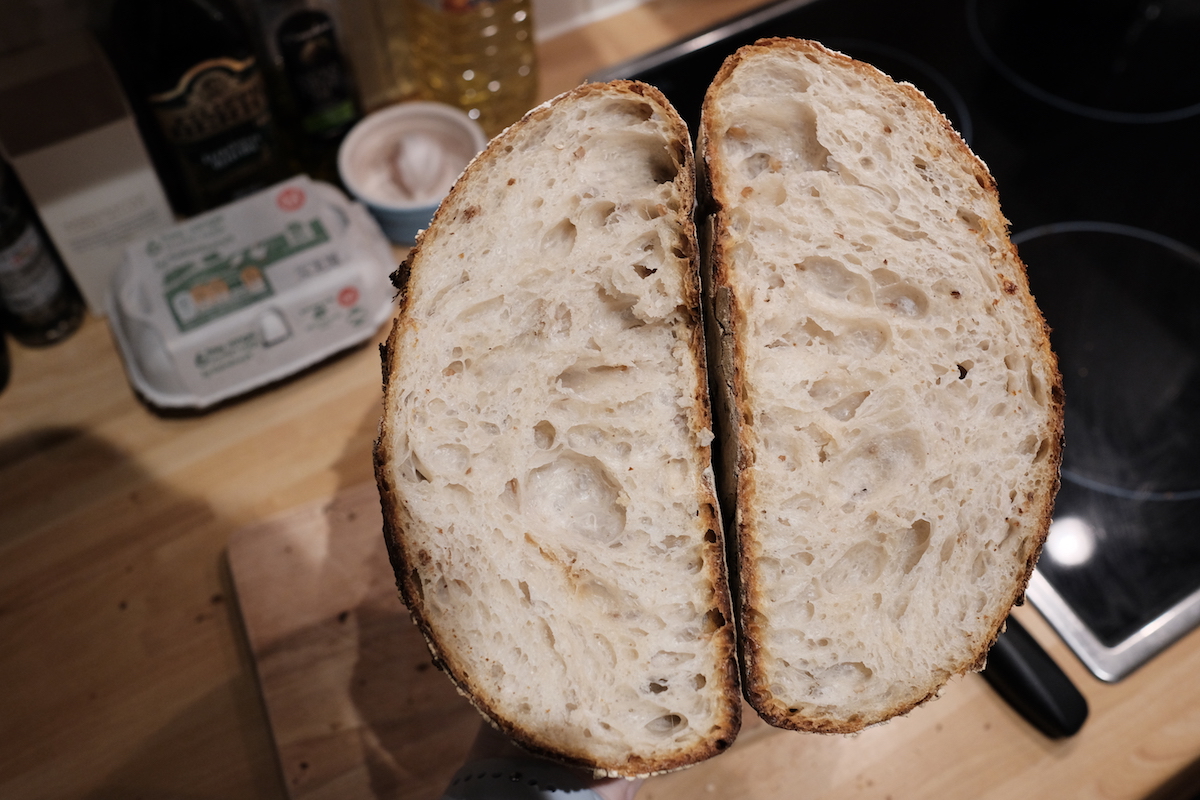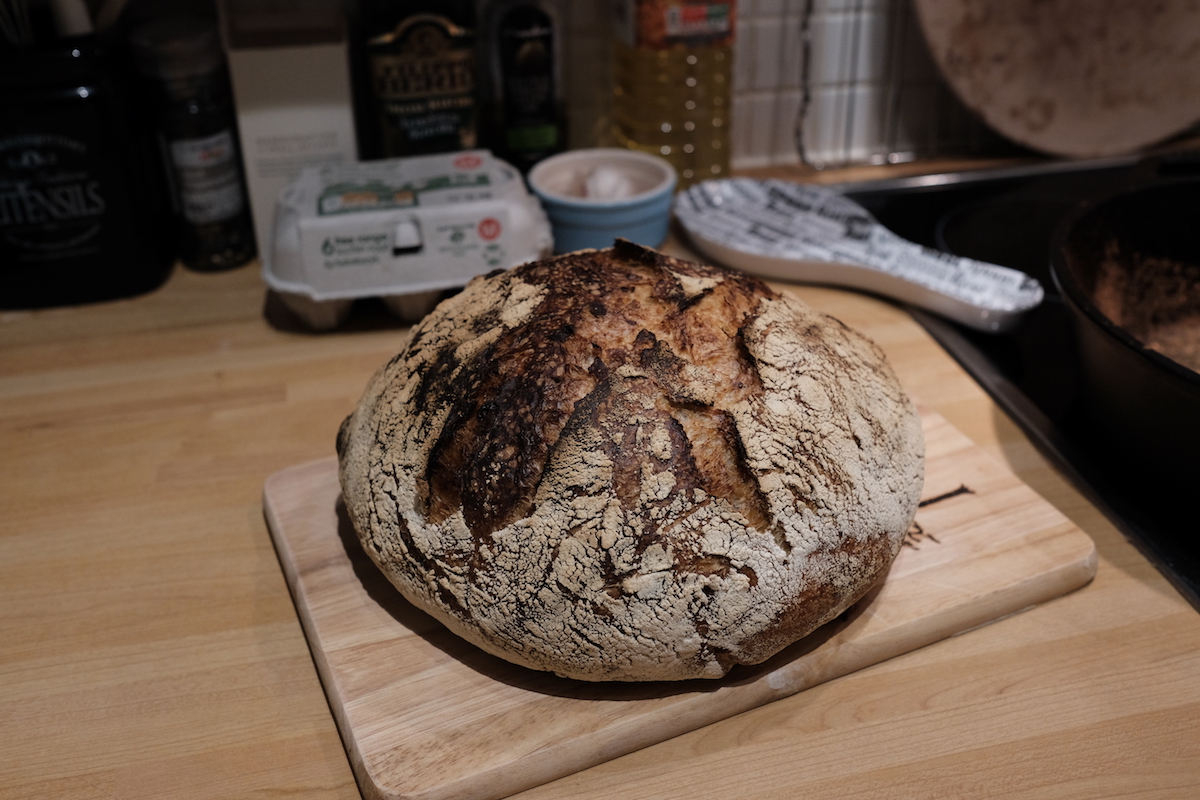-
My Best Camera
Between my third and fourth years of university, I worked as a distillery tour guide and as an intern software developer. By the end of the first month I bought my ideal camera - a Canon 6D - and a month later I picked up the Sigma 35mm 1.4 ART lens. Two years later I sold both of these and instead bought a second hand Fujifilm X-T20 and Fujinon 23mm 1.4 lens and bar a few nitpicks, I believe it was a brilliant swap to make.

What I miss from my Canon:
- Brilliant low light performance
- A solid handgrip
- Long battery life
- The detail of a full frame sensor
Here are the reasons I much prefer the Fujifilm:
1. It’s small and light
- The lens and body of the Fujifilm combined weight less than either the lens or the body of the Canon. This is probably the main factor for me. My Canon was brilliant but I had to consciously bring it places and it was so bulky that when I did take it places, I wouldn’t want to keep it out all the time. The X-T20, on the other hand, is so small and light that I can happily leave it slung over my shoulder, it comes with me far more often.

2. The digital viewfinder is brilliant
- Prior to getting this camera, I presumed that optical viewfinders were far superior to digital ones, on the contrary, this viewfinder works so much better for me than my Canon. You get focus peaking whilst looking down the viewfinder and whilst in manual focus, the middle of the screen zooms right in so you can get your shot pin-sharp. When you half-press the shutter, the screen zooms back out and you can compose your shot. It’s a great system that I wish all cameras had.

3. The in-camera JPEG processing is great
- If you set the X-T20 to JPEG mode than you can choose what film emulation is used to process your JPEGs. I now shoot in JPEG 90% of the time. I realized that I spent more time backing up and processing my photos than I ever did looking at them. Now, by shooting straight in JPEG, I don’t think nearly as much about processing and 99% of the time I am just as happy with the photos.

4. A physical aperture ring, shutter speed dial and exposure compensation ring
- Having physical controls for each setting feels great. Combining this and the brilliant film simulation gives you the closest you can get to shooting film without spending £10 per 30 shots of photos you take. Having an aperture ring has encouraged me to change the aperture in my photos far more often, I no longer shoot everything wide open and hope for bokeh.

5. Its friendliness
- This is a hard one to describe but people react differently to this camera than they do with large full frame cameras. This camera feels much more point and shoot and people are more comfortable both getting their picture taken and taking pictures themselves with it.

6. Charging over USB
- The X-T20 can be charged with any micro-USB cable. This is great for travelling as you don’t need to pack a camera specific charger and can even charge your camera using a battery pack. I regularly would forget the proprietary Canon charger and never wanted to fork out the cash for a spare one, so USB charging is a welcome change.
-
Steps Forward and Back
This weekend I forayed from the safety of my go-to Flour Water Salt Yeast book to try a recipe from The Perfect Loaf. The reasoning for this was that I was keen to improve the scoring on my bread. FWSY says that scoring is unnecessary and you are fine to just let your loaves split naturally. However, I’m keen to improve the neatness of my loaves and want to move on baguettes which will certainly require scoring. If you don’t score your loves they can split anywhere on the loaf as they expand - leading to a less even bake.
Going into this bake there were two factors I wanted to change in comparison to my previous loaves:
- I wanted to generate greater tension in the dough at both the folding and shaping stages. In practice, this should help the dough retain its shape and should make it easier to score.
- I wanted to try and follow the recipe someone who likes to score their bread. The key difference with this recipe was that your shaped dough sits in a proofing basket overnight, previously I would do a long bulk overnight and only waiting a short time after shaping to bake in the morning.
I had varied success with these goals. Maurizio from The Perfect Loaf calls for room temperature water to feed your starter prior to baking. However, my room temperature in cold Edinburgh flat at this time of year is around 14℃. Knowing this, I tried using warmer water (by 2-3 degrees) than the recipe called for. In retrospect, though I feel I should have gone even warmer, my final dough temperature still managed to be 3 degrees cooler than was expected in the recipe.
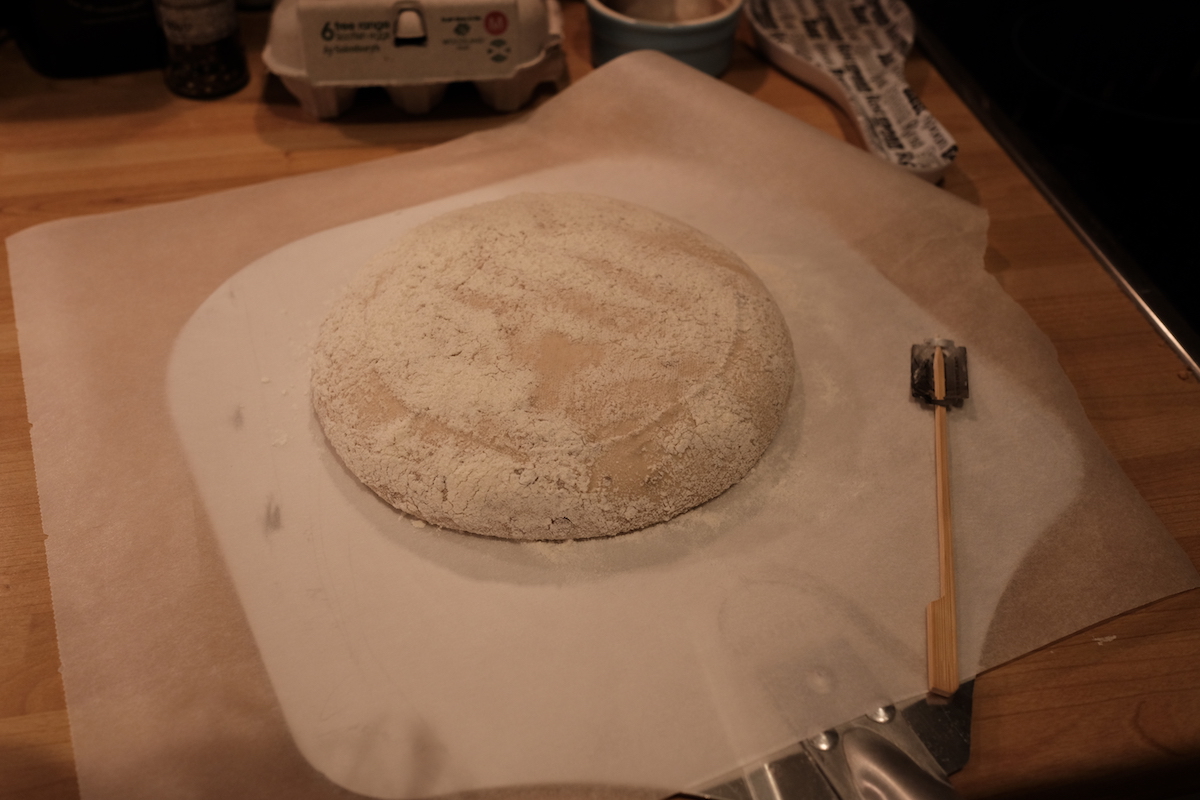
I was determined to get a tight ball when shaping my dough which proved difficult as I had possibly the wettest dough I have worked with yet. Over 5 minutes I eventually got a great round ball, but at the expanse of the great rise I generated with my starter. I noticed the next morning after baking my bread that I have been using Allinson’s Country Grain Bread Flour which I had naively presumed to be wholegrain flour - it is, in fact, a blend of various flours. I presume mixing this (which already contains a deal of white and rye flour) with my mix of white and rye flour resulted in skewed proportions of water to flour. From what I have read, rye flour will typically be less absorbent of water and will give you a stickier dough.
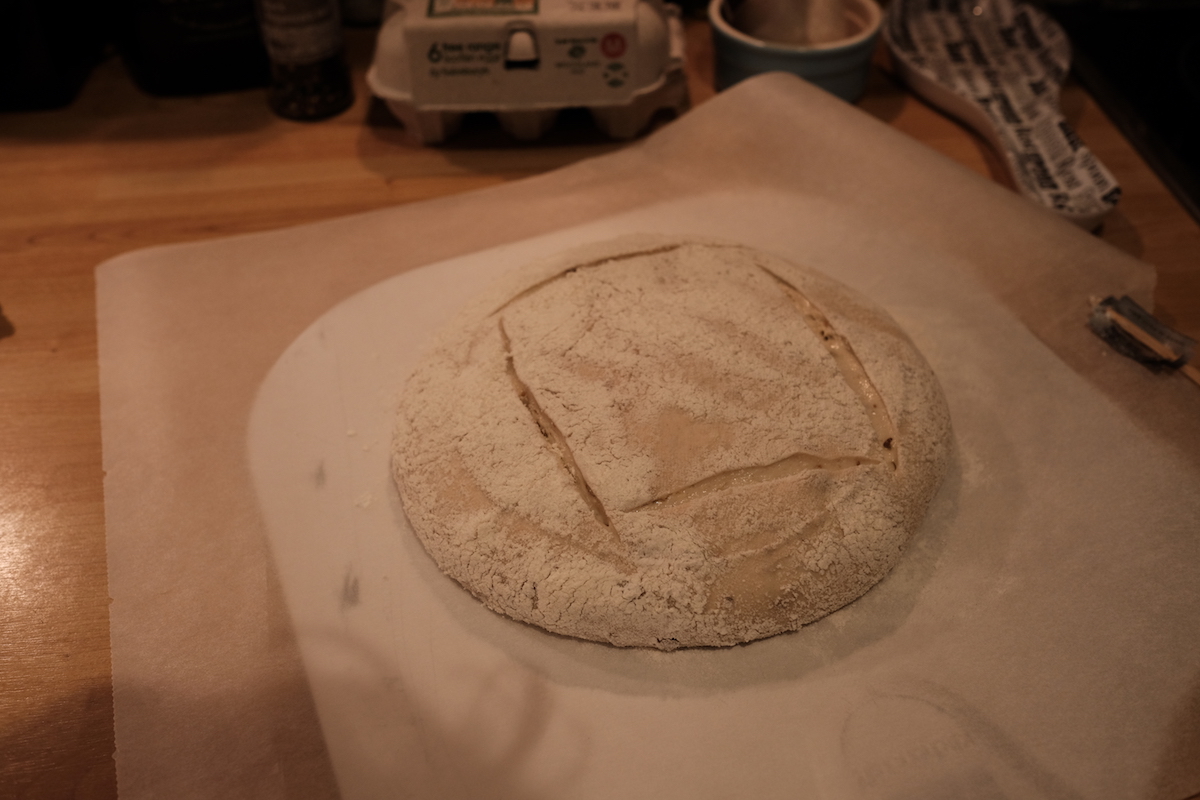
Although I struggled to shape the dough, the tension I generated seemed to have worked very well. Scoring the loaves worked really well, in the past the razor has immediately gotten stuck to the dough. In this case, it glided right through the dough no problem - I actually wish I had cut deeper and gone for a bigger cut once I knew that it was going to cut well.
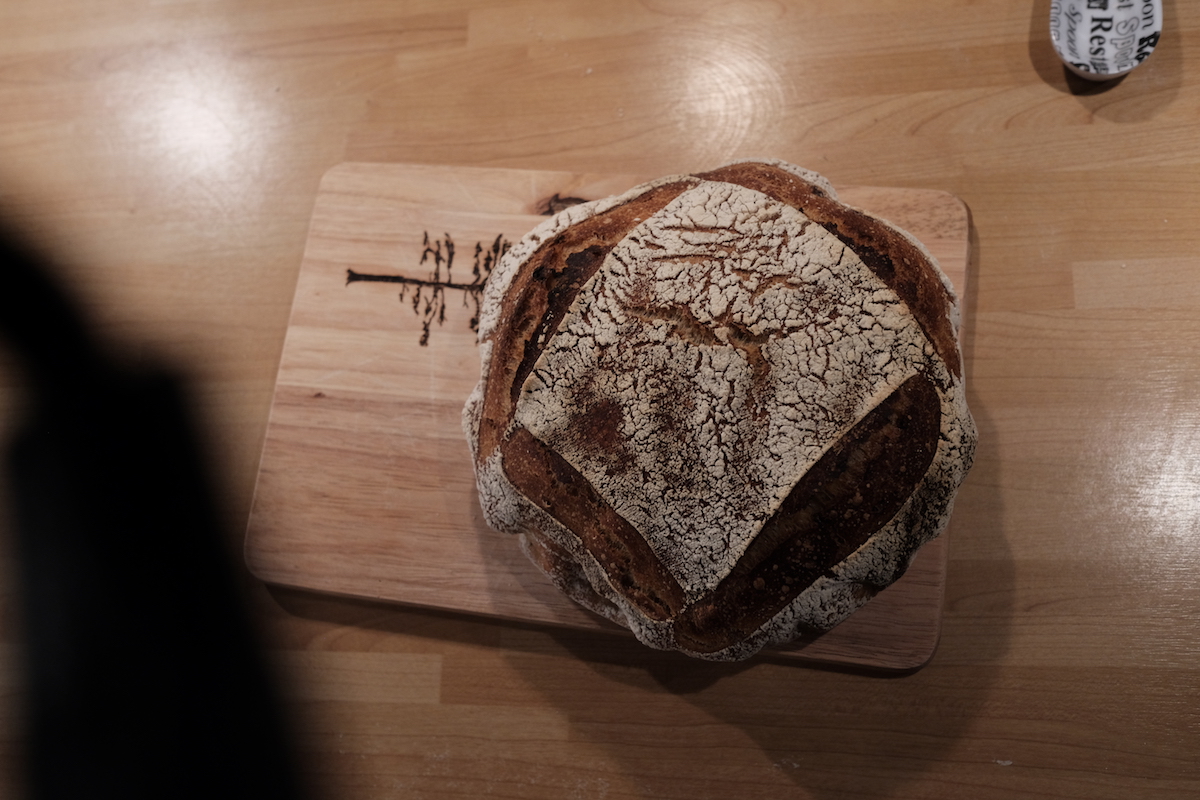
One other thing I have previously struggled with is getting the dough from the proofing basket to the counter and then to the combo cooker. I read on Maurizio’s blog that you can use baking paper and a pizza peel to invert the basket straight onto the paper which can simply be lifted in the pan. This turned out to be so much easier than trying to lift a wet dough with just my hands. The only downside to this was that I cooked the loaf in the deep pan of the combo cooker, this made the baking paper curl in at the edges and left me with a bumpy shaped loaf. In the future when I have a good tight boule, I will just cook in the lid (inverting the pan) and the paper should pull less at the edges of the dough.
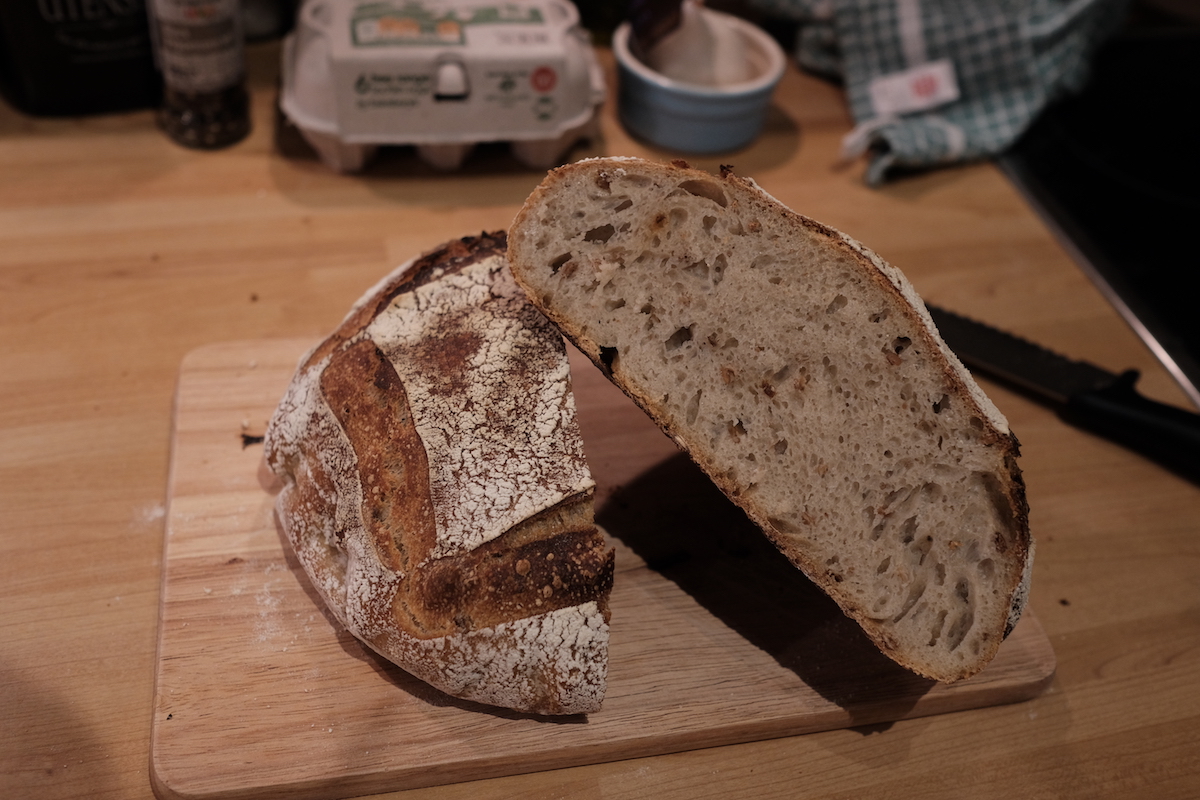
You can see here the boule had significantly less rise than my previous post. I believe this was due to me overworking the dough during shaping and also due to me mixing the wrong flours. I’m going to try again soon with the right flour, warmer water and I’ve also ordered a new dough knife from an Oban based bakery equipment fabricator.
-
Utilising Live Photos
Every iPhone since the 6S has had the ability to shoot Live Photos (a photo with the surrounding 1.5 seconds stored as video). There is nothing breakthrough about this ‘file format’, but I find them to be one of the nicest features of iOS. The video captured has a low frame rate (something around 15 fps) and takes up relatively little space. Unless you are completely void of storage space on your phone then I see no reason not to leave them enabled.
I wanted to write this post to share some uses of Live Photos that may be less apparent.
Instagram Boomerangs
Any live photo can be turned into a boomerang long after you took the photo. This is particularly nice as you can just quickly open the camera from your phone lock screen, take your pictures and later convert those live photos into boomerangs. To do this you need to go to the stories camera on Instagram, swipe up to view your camera roll, select a live photo and then press hard (3D touch) on the photo to turn it into a boomerang.
Google Motion Stills
This app is pretty simple but it can help you get much more use out of your live photos. You can convert them to GIFs, convert them to videos and also loop them. The best thing about this app though is it’s motion stabilizing. A shaky live photo can be perfectly still after be resaved as a Live Photo using Motion Stills. I regularly use this on my Instagram posts in order to get videos where only one part of the image is moving. I’ve also used the video export of this app quite extensively in order to create a holiday video where half the content was just the video portion of the Live Photos I took whilst away.
Darkroom
Darkroom has become my go-to photo editing app. I love not having to import photos, being able to batch edit efficiently and the fact that it properly uses Photos APIs so that you can ‘modify’ photos instead of saving a copy (I used to end up with multiple copies of photos I was editing in various apps). Recently the app added support for editing Live Photos, in that you can apply edits to a photo and those same edits are applied to the video portion of the Live Photo. I use a combination of this and Google Motion stills to create many of my Instagram posts.
The only caveat of using Darkroom and Motion Stills to create videos for posting on Instagram is that Instagram requires videos to be longer than 3-seconds. To get around this I created a simple app that queries your photos library for Live Photos. You simply tap on the photo you wish to post on Instagram and it will extract the video component of the LivePhoto, loop it as many times are required for you to get a 3 second video, and save it to your camera roll.
-
Podcast List - February 2018
I typically listen to a least one #podcast a day, the topics of which vary significantly. Here’s a list of some of my favorites podcasts this past year.
Crime/Thriller/Mystery
S-Town
I was recommended this podcast by a friend whilst in London and listened to all eight episodes during and after the train ride home the next day. It is one of the most interesting stories I’ve heard. It reminds me of Netflix’s Making a Murderer but is so much more personal. I don’t want to say too much about it as to not spoil the surprise, I would just advise you to go and listen to it now.
They Walk Among Us
I found They Walk Among Us whilst googling for crime podcasts and have been listening to each episode since. It tells the story of real British crimes and can be very dark at times. One odd/funny element is that Benjamin who narrates it uses the exact same voice and intonation to tell you about this weeks shaving sponsor as he does to describe someones brutal demise.
Serial
After finishing S-Town I was keen to hear more of the same and found that its creators had previously made Serial. I wouldn’t say it is as interesting as S-Town - it’s much slower paced - but I certainly enjoyed it.
Up and Vanished
Up and Vanished was created by a filmmaker - Payne Lindsay - who watched Making a Murder and listened to Serial and was inspired to make his own mystery podcast. Payne researched unsolved murder cases and came across the disappearance of Tara Grinstead. The podcast gets more and more interesting as it goes on. I would recommend you not to research it too much and just listen.
Science/Tech
Radiolab
Another podcast that I was introduced to by a friend. Radiolab produce shows about a massive variety of topics that are always thought-provoking and insightful. The podcast is really well produced - it always has cool sound effects and music and the issues they present have been researched by many people over months and sometimes years.
The Infinite Monkey Cage
A recent addition to my podcast playlist. This is a funny and informative show that is quite like watching QI but with more focus on certain topics in each episode. There are experts on each episode telling you about their area of expertise.
No Such Thing As A Fish
This show is 100% QI-in-a-podcast. It is hosted by the researchers at QI and is full of facts and puns.
The Accidental Tech Podcast
The Accidental Tech Podcast is the most Apple-y, tech-y podcast I think there is. There are some really great in-depth discussions about how Apple as a company is doing. Marco one of the hosts actually writes the podcast app I use - Overcast - and it can be really interesting to hear about their view of the iOS development world.
Discussions/Interviews
VIEWS with David Dobrik and Jason Nash
I watch pretty much every new David Dobrik video and it’s really interesting to hear the stories behind them. These podcasts can be ridiculous and completely millennial-focused but I always find them funny. It’s nice to hear a YouTuber who just openly talks about the money they’re making and how they genuinely think that they are so lucky to be in the position that they are in. Plus, he has a Tesla.
The High Low
My girlfriend got me on to this podcast, it’s vastly different from anything else I listen to but has become a podcast I look forward to listening to each week. It is hosted by Pandora Sykes and Dolly Alderton, two freelance writers who both went to private all-girls schools. The podcast is centered around pop culture and feminism, and I find it really interesting to hear their thoughts on topics in the news each week.
How I Built This with Guy Raz
How I Built This is a podcast where Guy Raz interviews the founders of massive companies. My favorite episodes include the founder of Patagonia, Five Guys and Instagram. It’s interesting to hear the differences in how people ‘made it’, and similarly interesting to hear how similar these stories can be (it’s amazing how many founders parents had $50,000 to invest in their offspring’s companies).
-
Things 3 + Workflow
I started using Things as my to-do list on iOS back in December and it has become one of my favourite apps to use. The latest version (3.4) added powerful deeplinking that allows you to create shortcuts and automate tasks within the app. For example, you can open the following URL on your Mac or iOS device to go straight to the today list -
things:///show?id=today.These deeplinks can perform complex generation of tasks that would be cumbersome to do manually. Inspired by a MacStories post I decided to use the app Workflow to automate my timers for making bread. A good bread doesn’t take a lot of hands on time to make, but it does require attention every few hours for a day (or more). Different flours with different rising agents can have very different schedules and I was keen to find an easy way to keep track of this without always having to refer to a book.
Workflow is an iOS app in which you write miniature programs to perform whatever tasks you like - you can read all about it on Macstories. The workflow I created gets the current time and works out the date and time of each step in the chosen recipe. These strings of date and time are then injected into a JSON body that I created using Things 3’s Swift developer tool. Here’s a trimmed down copy of this.
[ { "type": "project", "attributes": { "title": "Saturday White Bread", "notes": "Created Thursday 23/02", "items": [ { "type": "to-do", "attributes": { "title": "Autolyse", "when": "2018-02-23@15:20", "checklist-items": [ { "type": "checklist-item", "attributes": { "title": "500 grams flour" } }, { "type": "checklist-item", "attributes": { "title": "360 grams water. 35°C" } } ] } } ] } } ]The
whenattribute of the Autolyse step in this case would be swapped out with a calculated variable in Workflow. I created two workflows to manage the whole action, one workflow takes an input of minutes, adds those minutes to the current datetime, and outputs a string in theYYYY-MM-dd@hh:mmformat. The second - and main - workflow will continuously call the previous workflow with the minutes required for each step of the recipe. It puts the resulting datetime strings into a constant json body; uses a regular expression to remove the minify the json; and finally url encodes the resulting string. This is then opened in Things and the project with to-do items with reminders are created.A final adjustment I added was the ability to preview the times for the respective recipe without having to create the todo list. This took an
if-elseblock in the main workflow that gives the user options of whether to preview the times or do make the todo list. Doing this I can check if I have time to make a specific bread from my lockscreen or even my watch.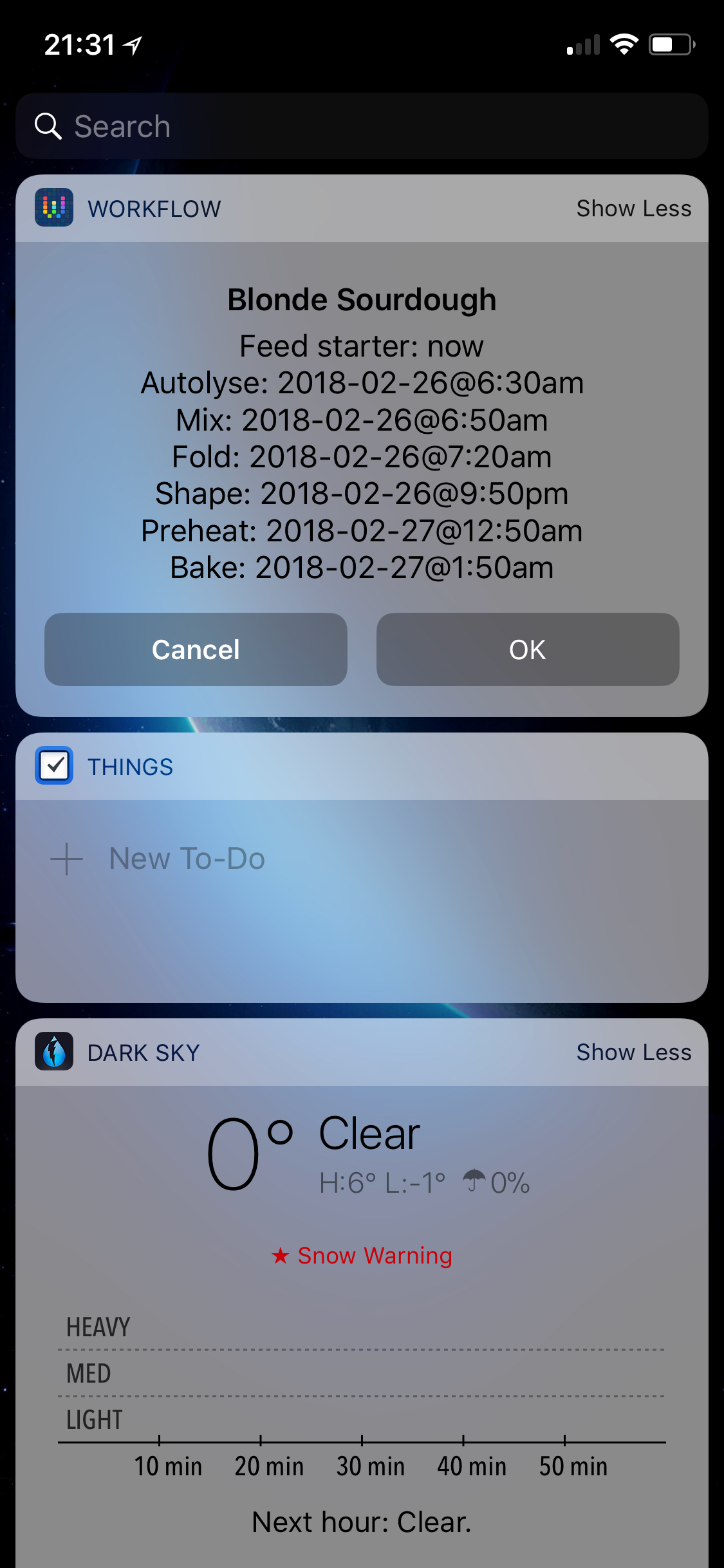
You can find the full workflow here and watch the workflow in action below.
-
Beginnings In Bread
A month ago I bought a copy of Flour Water Salt Yeast(FWSY) by Ken Forkish. In June of last year I bought his newer book The Elements of Pizza, which I really enjoyed. I find it particularly good for a number of reasons, the two key ones being that although it is written by a professional baker, it does not use unattainable utensils for the casual home baker and that it follows a traditional approach to baking - there are no overly fancy, or unecessary, modern quirks.
A week after buying FWSY I ordered a Lodge Cast Iron Combo Cooker and ever since have been baking fresh loaves twice a week.
This week I baked my first fully naturely leavened loaf and was delighted with the results.
